Hybrid solar systems operate similarly to traditional grid-connected solar setups, but they incorporate advanced hybrid batteries and inverters to store energy for later use. This capability makes them ideal not only for maximizing solar energy efficiency but also for providing a reliable backup power source during outages. Many homeowners prefer to stay connected to the grid while investing in robust battery backup systems, as this approach offers significant advantages, such as backup power and the opportunity to sell excess electricity back to utility providers.
Curious about how hybrid solar systems work and whether they could be the perfect fit for your energy needs? Let’s dive into the details. In this post, we’ll explore what a hybrid solar power system entails, its key components, and the many benefits it brings to the table. By the end, you’ll have a clearer understanding of whether a hybrid solar setup is the right choice for your home or business.

What is a Hybrid Solar System?
Solar energy generated by panels can’t be used directly—it needs conversion first. You can opt for staying connected to the grid, going fully off-grid, or choosing a hybrid solar power system. A hybrid solar system combines solar panels, a hybrid inverter, and a battery bank. The panels convert sunlight into direct current (DC), which is then stored in batteries for later use. If there’s leftover power, it can be sent back to the grid.
Unlike purely on-grid or off-grid systems, hybrid solar setups offer the best of both worlds. They allow you to keep using solar energy even if the grid goes down and provide seamless integration with the existing power infrastructure. Additionally, these systems often include smart features like net metering, which lets you earn credits for excess electricity fed back into the grid.
Key Components of a Hybrid Solar System
A hybrid solar power system typically consists of four main components: solar panels, a hybrid inverter, a battery storage unit, and a charge controller. Solar panels absorb sunlight and convert it into DC electricity. The hybrid inverter transforms this DC power into alternating current (AC), making it suitable for household use. Meanwhile, the battery stores any excess energy produced during sunny periods for nighttime or cloudy days. Lastly, the charge controller ensures efficient charging of the battery while protecting it from overcharging or deep discharging.
How Does It Work?
During daylight hours, solar panels generate electricity that powers your home appliances. Any surplus energy gets directed toward charging the battery. At night or when sunlight is insufficient, the stored energy in the battery kicks in, ensuring uninterrupted operation. In cases where the battery’s capacity is depleted, the system automatically switches back to the grid for supplementary power.
This dynamic balancing act between solar generation, battery storage, and grid usage makes hybrid solar systems highly versatile and efficient. They’re particularly beneficial for areas prone to frequent blackouts since they provide consistent access to electricity regardless of external conditions.
Advantages of Hybrid Solar Systems
There are several compelling reasons why people choose hybrid solar systems over other options. For starters, they help stabilize electricity expenses by shielding consumers from fluctuating utility rates. With built-in battery storage, users enjoy greater independence from the grid, reducing reliance on external suppliers. Plus, having a hybrid setup enhances sustainability by promoting renewable energy adoption.
-
Cost Efficiency
Hybrid systems deliver long-term cost savings thanks to their ability to optimize energy consumption patterns. By leveraging time-of-use pricing strategies, households can minimize peak-period charges and maximize returns from selling excess power back to utilities.
-
Reliability
One major perk of hybrid solar systems is their resilience against outages. Equipped with battery reserves, these systems guarantee continuous operation during emergencies, safeguarding sensitive equipment and maintaining comfort levels indoors.
-
Future Proofing
As technology advances, hybrid systems are designed to evolve alongside changing demands. Whether you need additional capacity now or plan expansions later, hybrid configurations offer flexibility and scalability unmatched by standalone alternatives.
Final Thoughts
Adopting a hybrid solar energy system represents a forward-thinking move towards sustainable living. Not only do such installations reduce monthly utility bills significantly, but they also contribute positively to environmental conservation efforts. Before committing to installation, however, consult with certified professionals who can assess site-specific requirements and recommend tailored solutions.
Have questions regarding implementing hybrid solar technologies at your property? Our dedicated support team is here to guide you through every step of the process. Reach out today—we’d love to hear from you!
Carbon/Texture/Pattern Vinyl,Carbon Wrap Car Cost,Rainbow Chrome Vinyl,Atin Red Chrome Wrap
Guangzhou Wanheyan Innovative Materials Co., Ltd. , https://www.wrapremi.com